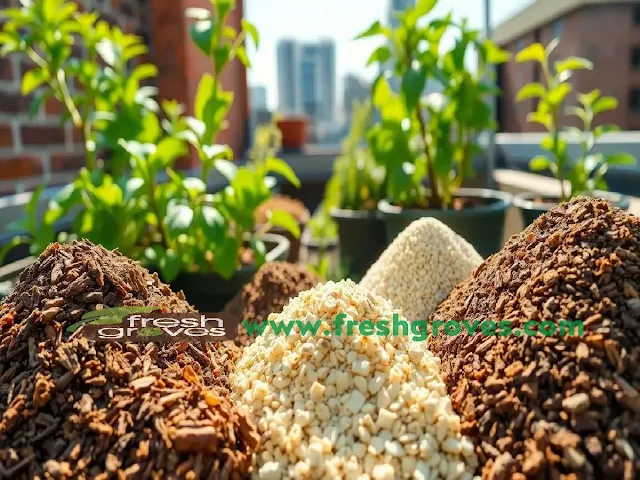Eco-Friendly Fertilizers for Urban Farmers: Sustainable Options
 |
| Eco-Friendly Fertilizers for Urban Farmers |
Urban farming is on the rise, with a 50% increase in community gardens and rooftop farms over the past decade. As cities grow, so does the need for sustainable practices that protect our environment. Conventional fertilizers, while effective, can contribute to serious issues like pollution and runoff, especially in densely populated areas. This article explores eco-friendly fertilizer options that urban farmers can use to enhance their crops while promoting sustainability.
Composting: Nature's Fertilizer
Benefits of Compost for Urban Farms
Composting turns organic waste into a nutrient-rich soil amendment. Here are some key advantages:
- Nutrient Content: Compost is packed with essential nutrients like nitrogen, phosphorus, and potassium.
- Soil Improvement: It improves soil structure, water retention, and biodiversity.
- Waste Reduction: Composting diverts organic matter from landfills, reducing your overall carbon footprint.
Creating Compost in Urban Spaces
Urban dwellers often face space constraints, but there are creative solutions:
- Vermicomposting: This method uses worms to break down waste, even in small apartments.
- Community Compost Initiatives: Partner with local groups to share resources and compost facilities.
Case Study: Successful Urban Farming with Compost
An example is the "Green City Growers" project in Cleveland. They utilize compost from local food waste to nourish their rooftop garden, leading to healthy produce and reduced waste.
Worm Castings: The Power of Vermicomposting
Nutrient Composition of Worm Castings
Worm castings are known for their high nutrient density. They contain:
- Nitrogen: Crucial for plant growth.
- Phosphorus: Helps in root development and fruit production.
- Beneficial Microbes: Improve soil health and boost plant resistance.
Setting Up a Vermicomposting System
Creating your setup is easy:
- Choose a Bin: A plastic container with air holes works well.
- Add Bedding: Use shredded paper, cardboard, or coconut coir.
- Introduce Worms: Red wigglers are ideal for composting.
- Feed Them: Add kitchen scraps, avoiding meat and dairy.
Real-world Example: Urban Farm Using Worm Castings
The "Urban Roots" project in Austin effectively uses worm castings to fertilize their garden beds. This method has vastly improved crop yields and soil quality.
Cover Cropping: Soil Health and Natural Fertilization
Selecting the Right Cover Crops
Cover crops can enrich the soil and prevent erosion. Consider these species:
- Clover: Fixes nitrogen and supports pollinators.
- Rye: Prevents weeds and improves soil structure.
- Buckwheat: Attracts beneficial insects.
Integrating Cover Crops into Urban Farming Systems
Plan your cover cropping schedule around your main crops:
- Sow Before Winter: Plant cover crops in the fall to protect the soil.
- Incorporate in Spring: Turn them under before planting your main crops.
Research on Cover Crop Effectiveness
Studies show that cover crops can increase soil organic matter and reduce the need for synthetic fertilizers. A research article published by the USDA highlights significant yield improvements when cover crops are used.
Using Natural Fertilizers: Manure and Seaweed
Benefits and Considerations of Manure
Different types of manure, such as chicken, cow, and horse, offer various nutrients:
- Nitrogen Content: Chicken manure is particularly rich in nitrogen.
- Risks: Always compost manure before use to avoid pathogens.
Seaweed as a Fertilizer
Seaweed is another natural option, known for its:
- Nutrient Composition: Packed with potassium and trace elements.
- Application Methods: Can be applied as a liquid fertilizer or dried and chopped as a mulch.
Sourcing Sustainable Materials
Finding eco-friendly manure and seaweed can involve:
- Partnering with local farms.
- Searching for organic or sustainably sourced options at garden centers.
Aquaponics: A Closed-Loop System
How Aquaponics Works
Aquaponics combines fish farming with plant cultivation in a symbiotic environment:
- Fish Waste: Provides nutrients for plants.
- Plants: Filter and clean the water for the fish.
Nutrient Cycling in Aquaponics
This method significantly reduces the need for additional fertilizers, making it an ideal option for urban settings. The water is continuously cycled, providing a sustainable source of nutrients.
Implementing Aquaponics in Urban Settings
Start small with your own aquaponics system:
- Choose Your Fish: Tilapia or goldfish work well.
- Select Plants: Lettuce, herbs, and small vegetables thrive in these systems.
- Monitor Systems: Keep an eye on water quality for optimal growth.
Conclusion
Eco-friendly fertilizers play a vital role in urban farming, providing numerous benefits like soil health, pollutant reduction, and waste management. These sustainable methods are essential for the future of urban agriculture and the planet. By incorporating composting, worm castings, cover cropping, and aquaponics, urban farmers can lead the way in creating a healthier environment. It’s time to embrace these eco-friendly practices and cultivate a greener, more sustainable future. Let’s get started on adopting these remarkable methods today!

